Want to make great videos without all the hard work? You’re in the right place. This guide shows you exactly how to use text to video AI to create videos that look professional and get attention.
People watch almost 20 hours of videos every week now. And here’s the good news – you can make videos they’ll love to watch using just your words. Let me show you how to use these amazing AI video tools step by step.
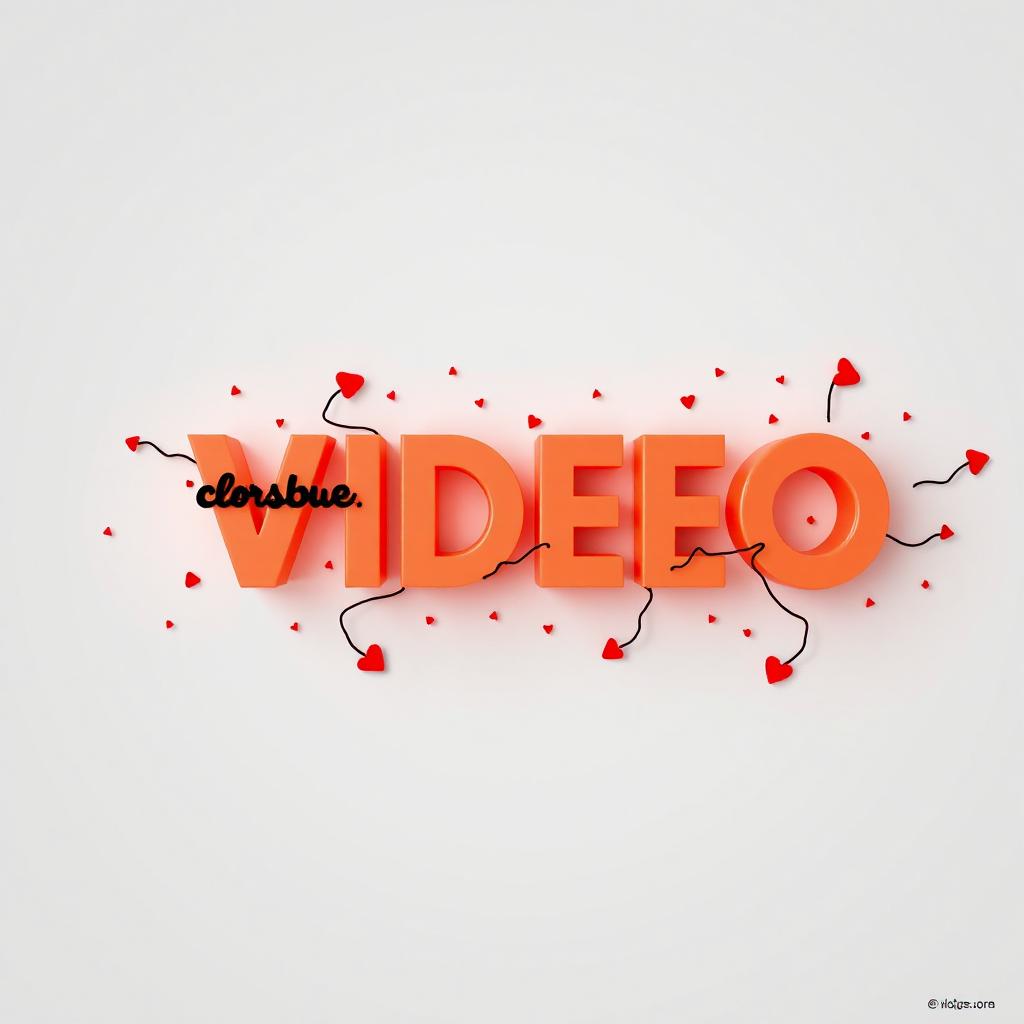
Getting Started with Text to Video AI
Making your first video might feel tricky. But don’t worry – I’ll show you exactly what to do. The text to video generator makes things much easier than traditional video making.
Setting Up Your First Project
First, pick which text to video maker you want to use. Some good ones let you start for free. Just type the tool’s name in your web browser and click ‘Sign Up’ or ‘Get Started’.
Signing up usually takes just a minute. You’ll need:
- An email adress
- A password
- Your name
After you sign up, look around the main screen. Most AI video generators show you a big button that says ‘New Video’ or ‘Create’. Click that to start your first project.
Understanding the Interface
The text to video online tools usually have three main parts:
First, you’ll see where to put your text. It looks like a simple writing box. This is where you’ll type what you want your video to say.
Next, look for the style options. These let you pick how your video will look. You might see choices like ‘Professional’, ‘Fun’, or ‘Educational’.
Last, find the preview section. This shows you how your video looks before you finish it. Good AI video creation tools let you watch parts of your video while you work on it.
Writing Scripts for AI Videos
The words you write make a big difference in how good your video turns out. Let’s look at how to write scripts that work great with text to video AI.
Script Structure That Works
Start with something that grabs attention. Maybe a surprising fact or an interesting question. The automated video creation works best when you hook viewers right away.
Keep your sentences short and clear. Instead of writing “The implementation of proper dietary habits can lead to significant improvements in overall health outcomes,” write “Eating better helps you feel better.”
Break up long ideas into smaller chunks. The AI video generator makes better scene changes when you write this way. Think of each paragraph as one scene in your video.

Optimizing Text for AI
The text to video processing works best with clear descriptions. Help the AI understand what you want to show. Here’s how:
Bad example: “Coffee preparation is important.” Good example: “Pour the hot water slowly over the coffee grounds in a circular motion.”
Use action words. The video generation picks better scenes when you say exactly what’s happening. Words like ‘pour’, ‘open’, ‘walk’, or ‘smile’ help the AI choose the right visuals.
Creating Your First AI Video
Now comes the fun part – making your actual video. The text to video AI makes this pretty simple, but let me show you some tricks I’ve learned from making hundreds of these videos.
Step-by-Step Process
Start by copying your script into the text to video maker. Take a moment to read it over one last time. Check for any spelling mistakes – they’ll show up in your video if you don’t catch them now.
Once your text is in, the AI video generator starts working. It’ll read your words and start picking scenes. This usually takes a few minutes. During this time, you can start picking other things for your video.
Voice choice matters a lot. The text to video processing usually gives you several voices to pick from. Try a few different ones with a short part of your text. Pick the one that sounds most natural for your topic. A fun video needs an upbeat voice. A business video needs a professional one.
Music comes next. Most AI video creation tools have lots of free music to choose from. Pick something that doesn’t fight with your voice. The music should stay in the background, supporting your message without taking over.
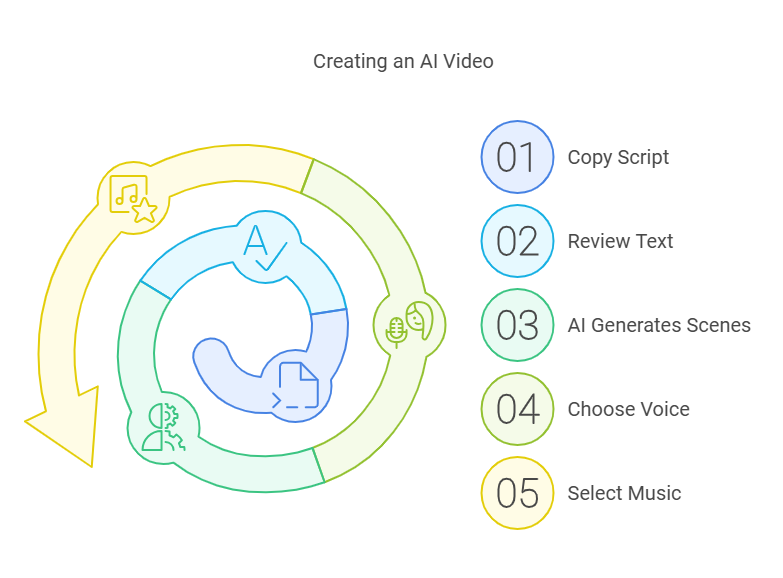
Quality Settings
Your video needs to look good where people will watch it. The automated video creation tools usually let you pick different video qualities. Higher quality looks better but makes bigger files.
For most social media, pick 1080p quality. It looks good everywhere and won’t take forever to upload. If you’re making videos for your phone, you might want to pick vertical video format instead of horizontal.
The AI video synthesis can export your video in different formats. MP4 works almost everywhere, so stick with that unless you need something specific.
Advanced Features and Tips
After you’ve made a few basic videos, try some more advanced stuff. The text to video tools can do some pretty cool things once you know how.
Voice and Audio Control
Good AI video generation isn’t just about the pictures – sound matters too. You can actually make the AI voice sound more natural by adding punctuation in smart places. A comma makes the voice pause briefly. A period makes a longer pause.
Try adding […] where you want longer pauses. Many text to video converters use this to make the timing better. It helps when you’re showing something that needs a moment to sink in.
Background music should match your content. Making a cooking video? Pick light, happy music. Business presentation? Go with something subtle and professional. The AI video maker usually lets you adjust how loud the music plays compared to the voice.
Visual Customization
Your videos don’t have to look like everyone else’s. Most text to video AI tools let you pick different styles. Some make your video look like a cartoon. Others go for a more serious, business look.
Colors matter too. If you’re making videos for your business, use your company colors. The video generation tools usually let you pick color schemes. This helps make all your videos look like they belong together.
Common Problems and Solutions
Even the best text to video AI sometimes needs a little help. Let’s talk about fixing the most common issues you might run into.
Fixing Scene Mismatches
Sometimes the AI video generator picks scenes that don’t quite match your words. This happens most often with specific or technical topics. For example, if you write about a “sleek modern office,” but get scenes of old offices, you need to be more specific.
Try breaking down your descriptions. Instead of “modern office,” write “office with glass walls, white desks, and computer screens.” The more specific you are, the better the text to video processing understands what you want.
Another trick is watching your video in small chunks. The automated video creation lets you preview parts of your video while working. If one scene looks wrong, change just that part of your text and let the AI try again.
Audio Issues
Sound problems happen sometimes too. Maybe the voice sounds too fast, or the music’s too loud. Good news – these are usually easy to fix.
Voice too fast? Add more punctuation. The AI video synthesis uses these marks to control timing. Add periods where you want the voice to pause longer. Use commas for shorter pauses.
Music problems usually come from picking the wrong track. The text to video maker gives you lots of choices. Pick music that stays in the background. If you can’t focus on the voice because the music grabs your attention, that’s the wrong music.
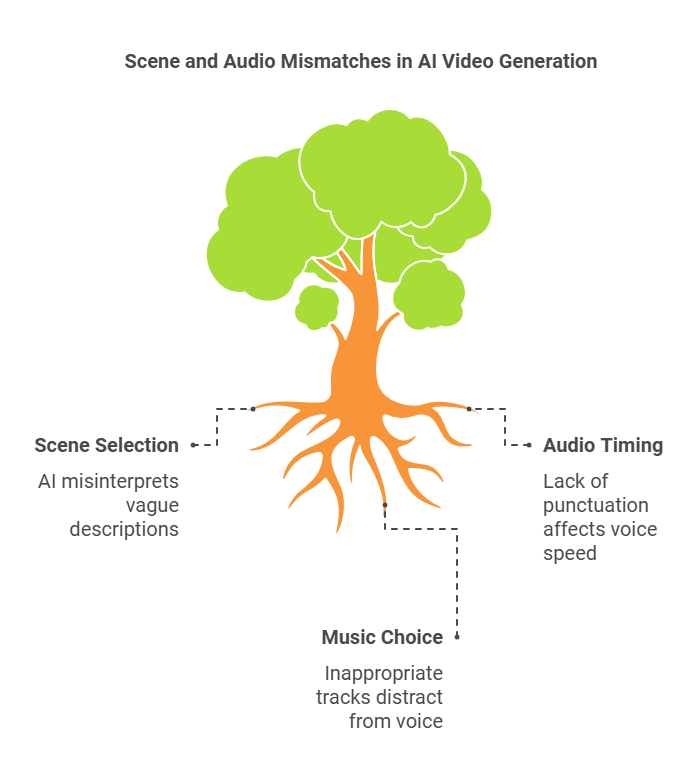
Tips for Different Video Types
Different videos need different approaches. Let’s look at what works best for each type of video you might want to make.
Social Media Videos
Social media needs quick, catchy videos. The text to video AI works great for these, but you need to follow some simple rules.
Keep these videos short – 30 seconds to 1 minute works best. Start with something that grabs attention in the first 3 seconds. The AI video creation lets you pick exciting opening scenes.
Use text overlays for people watching without sound. Many people scroll through social media with their sound off. The video generation tool can add captions automatically.
Business Presentations
Business videos need to look professional. The text to video generator has special settings for business content.
Pick clean, simple styles for business videos. Avoid flashy effects or loud music. The AI video maker usually has a “Business” or “Professional” style option – use that.
Include your company’s colors and logo if you can. Professional text to video tools let you add your own images and pick specific colors to match your brand.
Educational Content
Teaching through video needs its own approach. The text to video AI can make great learning videos if you know how.
Break complex ideas into simple parts. Explain one thing at a time. The automated video creation works better when ideas flow step by step.
Use examples people know. If you’re teaching something new, compare it to something familiar. The AI video generation picks better scenes when you use clear, relatable examples.
Cost-Saving Strategies
You don’t need to spend a lot to make good videos. Smart use of text to video AI can save you money.
Start with free tools. Most AI video generators let you make some videos without paying. Use these to learn how everything works. Once you know what you’re doing, you can decide if you need paid features.
Many tools offer monthly plans. If you need to make lots of videos, paying for one month and making them all then can save money. The text to video processing works just as fast whether you make one video or twenty.
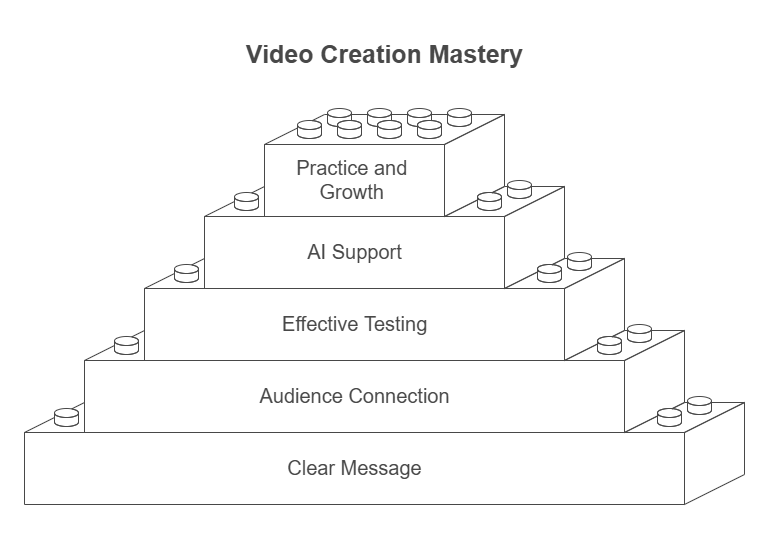
Final Tips and Best Practices
After making lots of videos with text to video AI, you learn what really matters. Here are the most important things to remember.
Keep your message clear. Fancy effects don’t matter if people don’t understand your point. Let the AI video synthesis support your message, not overshadow it.
Test your videos before sharing them. Watch them all the way through. Listen with sound on and off. The best text to video makers let you make changes easily if something’s not right.
Start small and practice. Each video teaches you something new about working with AI. Soon you’ll make videos that look like they took hours to create, even though you made them in minutes.
Remember – good videos connect with people. All the fancy AI video creation features don’t matter if your message doesn’t reach your audience. Focus on what you want to say, and let the AI help you say it well.
Frequently Asked Questions About How To Use Text to Video AI
What is Text to Video AI?
Text to video AI technology represents advanced artificial intelligence systems that transform written content into complete video presentations. The AI video generator analyzes every word and phrase you write, then creates matching video content by understanding the context and meaning of your text.
These text to video tools work through several smart systems working together. First, they read and understand your text, breaking down key elements like actions, descriptions, and topics. Then, the video generation system matches these elements with appropriate visuals, either by selecting from a vast library of clips and images or by generating new visuals that fit your content.
The AI video creation process also handles audio elements automatically. It can convert your text into natural-sounding speech, select appropriate background music, and time everything perfectly. The system knows how to match the pace of visuals with the flow of your words, creating a seamless viewing experience.
Advanced text to video processing even understands context and emotion in your writing. If you’re describing something exciting, it picks upbeat music and dynamic visuals. For serious topics, it chooses more professional and subdued elements. All this happens automatically, turning what used to be hours of video production work into a process that takes just minutes.
How do I start using a Text to Video AI tool?
Starting with text to video AI involves a clear step-by-step process. First, you need to select a platform that offers text to video generation. Each platform provides different features and capabilities, so choosing the right one matters.
Once you’ve picked your platform, creating your script comes next. The AI video generator needs clear, well-structured text to work with. Write your content thinking about how it will translate to video. The text to video processing works best with organized, scene-by-scene descriptions.
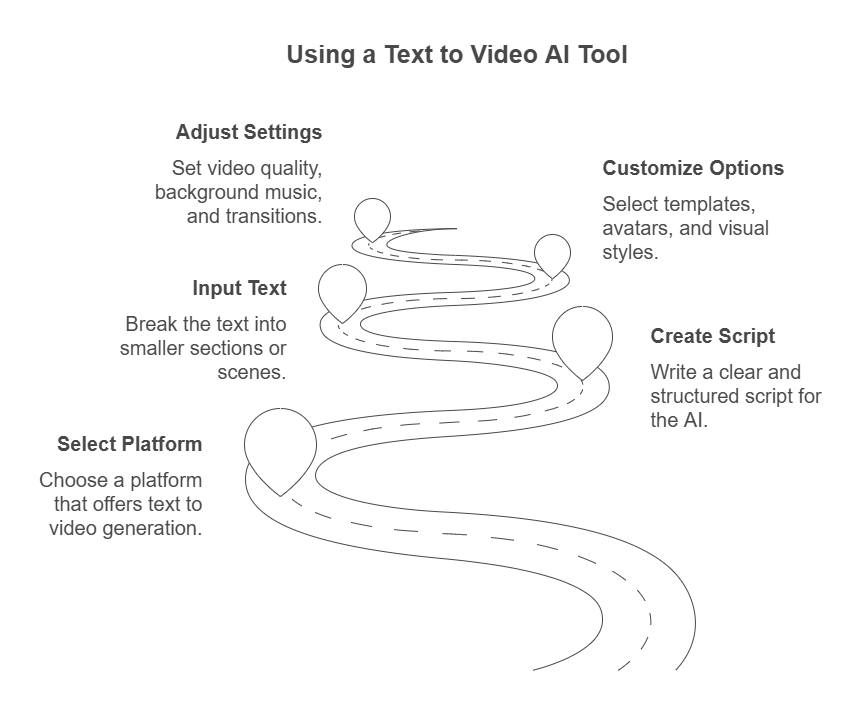
When inputting your text, most AI video makers let you break it into smaller sections or scenes. This helps the AI understand where to change visuals and how to pace your video. You can mark different parts for different treatments – some for talking heads, others for showing products or actions.
The platform then offers customization options. The automated video creation tools let you pick from various templates, AI avatars, and visual styles. You’ll also choose voice settings, since the text to video synthesis includes converting your words to speech.
Finally, you’ll adjust settings like video quality, background music, and transitions. The AI video production system takes all these choices into account when creating your final video.
What are the benefits of using Text to Video AI?
Using text to video AI brings multiple advantages to content creation. Time efficiency stands as one of the biggest benefits – what used to take days of filming and editing now happens in minutes. The AI video generator automates complex processes that traditionally required entire production teams.
Cost savings prove significant too. Traditional video production needs cameras, lighting, editing software, and often professional help. With text to video tools, you only need a computer and your ideas. The video generation system provides all the technical elements you’d normally have to buy or rent.
Accessibility opens video creation to everyone. You don’t need video experience or technical skills. If you can write clear text, the AI video maker can turn it into professional-looking content. This democratizes video production, letting small businesses compete with bigger ones.
The multilingual capabilities add another layer of value. Your text to video processing can create versions in different languages without re-filming anything. The AI handles translation and voice generation, keeping the same visual quality across all versions.
Can I customize my videos?
The text to video AI tools offer extensive customization options. You get full control over how your final video looks and sounds, starting from basic elements to advanced features that make your content unique.
Most AI video generators let you control visual style completely. You pick the look you want – professional and clean for business videos, bright and fun for social media, or calm and focused for education. The video generation system adapts all its choices based on your style picks.
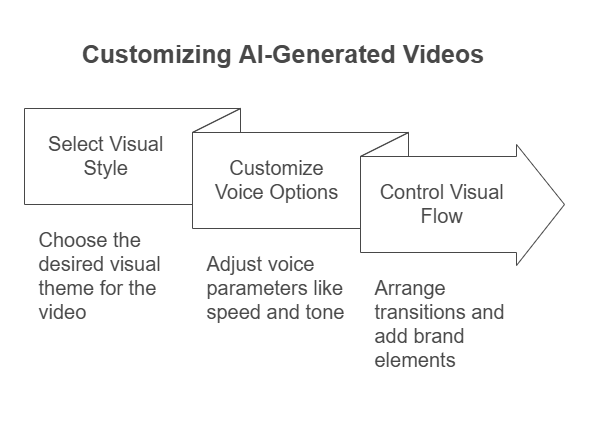
Voice customization goes deep too. The text to video processing lets you choose from many voice options. You can pick different speakers, adjust how fast they talk, and even change their tone. Some advanced AI video makers let you add pauses and emphasis just where you want them.
The visual flow stays in your control too. You can pick transitions between scenes, add your own logos or images, and choose color schemes that match your brand. The automated video creation follows your choices while keeping everything looking professional.
What types of content can I create with Text to Video AI?
The text to video AI works great for many different types of videos. Educational content turns out really well – you can explain complex ideas clearly, showing examples while a voice explains everything. Teachers use these tools to make lessons more interesting.
Marketing videos come out looking professional with AI video generation. You can make product demos, show how things work, or create ads that grab attention. The text to video maker keeps everything looking clean and professional.
Social media content works especially well. The AI video creation tools know how to make short, catchy videos that people want to watch and share. You can make different versions of the same content for different platforms – shorter for TikTok, longer for YouTube.
Training videos for businesses benefit from text to video processing too. You can create clear, step-by-step guides that help people learn new skills or understand processes. The AI makes sure everything stays clear and easy to follow.
Are there limitations on video length and format?
The text to video AI tools do have some limits you should know about. Each AI video generator sets its own rules about how long your videos can be and what types you can make.
Most text to video makers let you create videos between 1 and 5 minutes long. This works fine for most social media and quick explainer videos. Some tools let you make longer videos, but you might need to pay more. The video generation quality stays the same no matter the length.
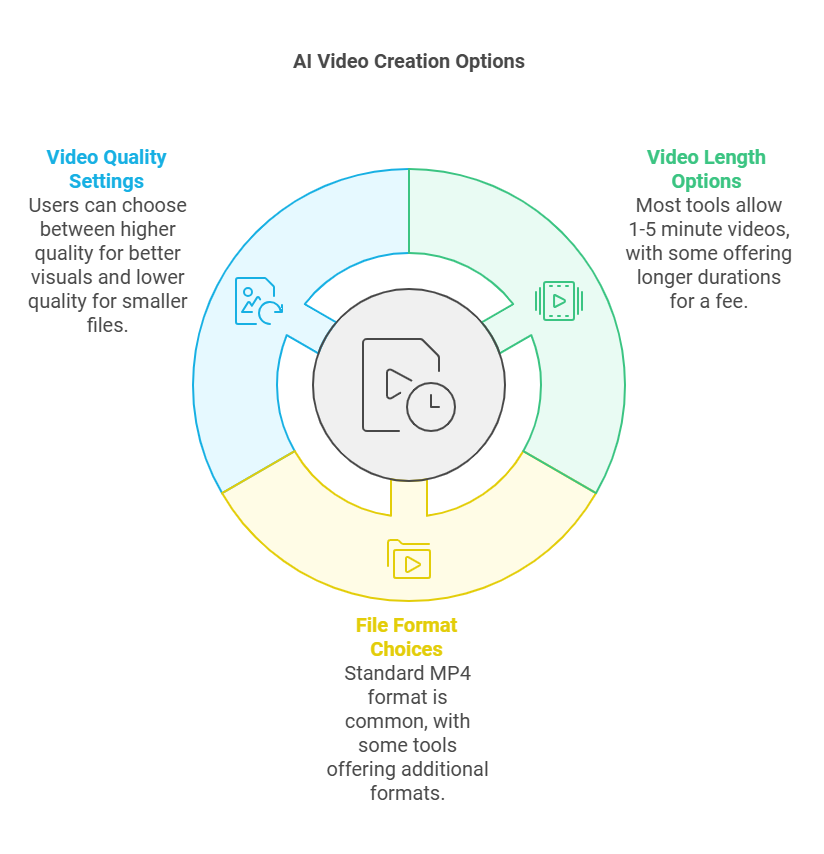
File formats stay pretty simple. Most AI video creation tools give you standard MP4 files. This works great because almost everything can play MP4s – phones, computers, websites, social media. Some advanced tools offer other formats too, but MP4 usually does the job.
Video quality options matter too. The automated video creation usually lets you pick between different qualities. Higher quality looks better but makes bigger files. Lower quality makes smaller files that upload faster to social media.
Is there a learning curve associated with these tools?
Getting started with text to video AI is pretty easy. Most people can make their first video in about 30 minutes. The text to video processing works in a way that feels natural – if you can write a clear message, you can make a video.
Sure, you’ll get better with practice. After making a few videos, you’ll learn little tricks that make your content better. The AI video maker usually comes with helpful guides that show you what works best.
The hardest part might be learning what kinds of text work best for videos. Writing for video generation is different from writing emails or documents. But the tools help you learn – they show you right away how your words turn into video scenes.
Most text to video tools now have good help sections and tutorials. If you get stuck, you can usually find quick answers. Plus, many offer example videos you can learn from.
What are some popular Text to Video AI tools in 2024?
Several text to video AI platforms lead the way in 2024. Each one does things a bit differently, so knowing what’s special about each helps you pick the right one.
Popular AI video generators stand out for different reasons. Some make really natural-looking videos with smooth movements and realistic voices. Others excel at making quick social media content that gets attention.
The best text to video processing tools keep getting better. They add new features regularly, like better voices, smoother animations, and more style options. The video generation quality improves all the time.
Remember that the best tool depends on what you want to make. Some work better for business videos, others for social media. The AI video creation style should match what you’re trying to do.
Link Sources:
https://www.zebracat.ai/post/how-to-make-ai-videos-secret-tips-toolkit-and-examples
https://www.linkedin.com/pulse/how-convert-text-ai-videos-step-by-step-guide-unscriptai-qq6fc
